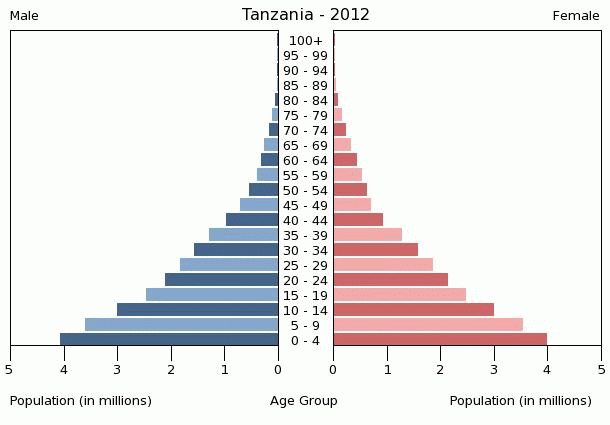
44,929,002. That is how many Tanzanians were counted. They can go on and
make the last digit 3 because I had to leave the country a week before
the census.
All jokes aside, Tanzania has experienced an exceptionally high
population growth – from 11 million in 1963 to about 45 million in 2012.
Among the factors that have contributed to this increase –one of the
fastest in the world– is the falling mortality rate. Life expectancy in
Tanzania has increased over the past two decades from 50 to 58 years.
In addition, Tanzanian women have continued to have many children (5.4
per woman in 2010), which is higher than Kenya and Rwanda (4.6) as well
as other sub-Saharan countries with the exception of Uganda.
Since 1991, this rate has only declined by 13 percent in Tanzania
against 26 and 31 percent in Rwanda and Kenya, respectively. Several
other factors have also contributed to the high population growth rate
that Tanzania is experiencing:
Infant mortality has halved over the last 25 years.
Early marriage: the median age at first marriage in 2010 was 18.8 years
in Tanzania compared to 20.0 in Kenya and 21.4 in Rwanda.
Early motherhood: 44 percent of Tanzanian women are either pregnant or are mothers by the age of 19.
Insufficient education: Reaching secondary education considerably delays
the age at first marriage and girls with secondary education wed at
about 23 years in Tanzania, Kenya and Rwanda. In 2010, women who had no
education had twice as many children as those who had attained secondary
education.
The average desired number of children for Tanzanian women remains high at 5.3 per woman.
Timid family planning programs; The use of contraceptives has stalled
with only 27 percent of women using modern contraceptives in 2010
compared with 39 percent and 26 percent in Kenya and Rwanda respectively
in the same year.
With the current fertility and mortality rates, Tanzania’s population is
projected to reach 100 million in 2035 and 200 million by the end of
this century. These projections raise a number of questions:
Will there be enough food to feed 100 million people in 2035?
How can enough jobs be created for the mounting youthful population?
Will there be enough resources to provide high-quality education,
infrastructure and other basic services for the coming generation?
Will economic development and urbanization be sufficient to reduce population growth over time?
Should the Government promote family planning programs like Ethiopia and Rwanda have done?
How can more men be encouraged to participate in family planning programs?
Should targeted education programs be implemented to encourage girls to remain in schools?
What should the role of development partners, communities, civil society and religious leaders be?
Note: The statistics used here are extracted from the 2010 World
Population Prospects and various issues of Demographic and Health
Surveys for Tanzania, Kenya, Uganda and Rwanda. All are publicly
available.
What are your thought?
Wednesday, May 8, 2013
Can Tanzania Afford To Have100 Million Citizens in 2035?
10:55 AM
No comments
Subscribe to:
Post Comments (Atom)











0 comments:
Post a Comment